Last time, I discussed the first problem in killing a carrier, that of finding it. That alone is a challenge, but the problems for the attacker aren’t over at that point.
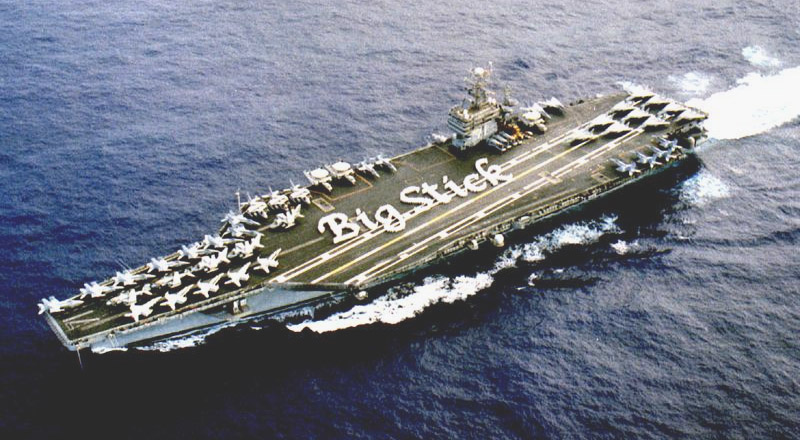
USS Theodore Roosevelt
The second line of the defense is the proactive measures the US will take to reduce the threat facing the carrier group. The USN learned at Pearl Harbor that it is better to give than to receive. First, submarine-launched Tomahawks will attack the enemy’s key infrastructure. Command and control facilities, communications links, logistics depots and air and naval bases will be targeted, reducing the enemy’s ability to find, fix, and attack the carrier groups. Tomahawks from the carrier’s escorting destroyers and air strikes from the carrier’s own airplanes will take over as the CVBG1 closes with the enemy coast. If an attack is detected before missile launch, airplanes will be vectored out to meet it. During the Cold War, US doctrine was that fighters would deal with airplanes, and SAMs took over after missile launch. Similar tactics are likely to be used today. Making hard estimates of effectiveness of these measures is very difficult, particularly as they depend heavily on circumstances, but they will be very important in a real war.
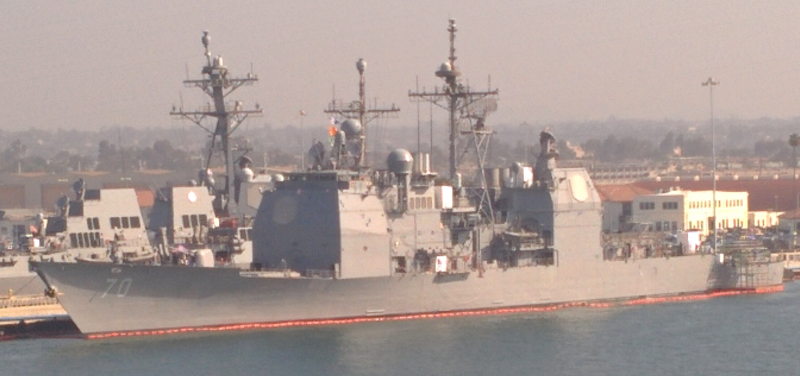
Cruiser Lake Erie at San Diego Naval Base
But leaving all that aside, how many missiles do I need to put in the air to take out a carrier? A typical CVBG has a Nimitz class carrier (CVN), a Ticonderoga class cruiser (CG), and 3-4 Arleigh Burke class destroyers (DDGs). All except the carrier have Aegis, the USN’s integrated air and missile defense system, and are equipped with Vertical Launch Systems (VLS) that allow them to vary what missiles they carry. The CG normally carries the burden of long-range air defense, while the DDGs are configured to protect themselves and execute land-attack missions. If the CVBG is going up against China, or into some other high-threat area, the DDGs are perfectly capable of carrying more SAMs, and a second CG might be assigned.2
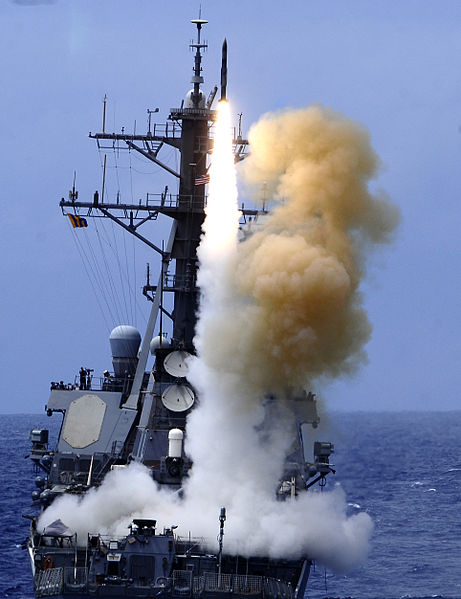
Destroyer Benfold launching an SM-2
The outer layer of the missile defenses is composed of Standard Missiles, the USN’s long-range air defense missile since the 60s.3 There are two subvariants, Extended-range and Medium-range. The ER variant has a range of 200 nm, while the MR version is around 90 nm. For a normal, peacetime carrier group, you have the CG with 96 of these4 providing the outer layer of fleet air defense.5 In an air-defense configuration, a DDG would carry 72.
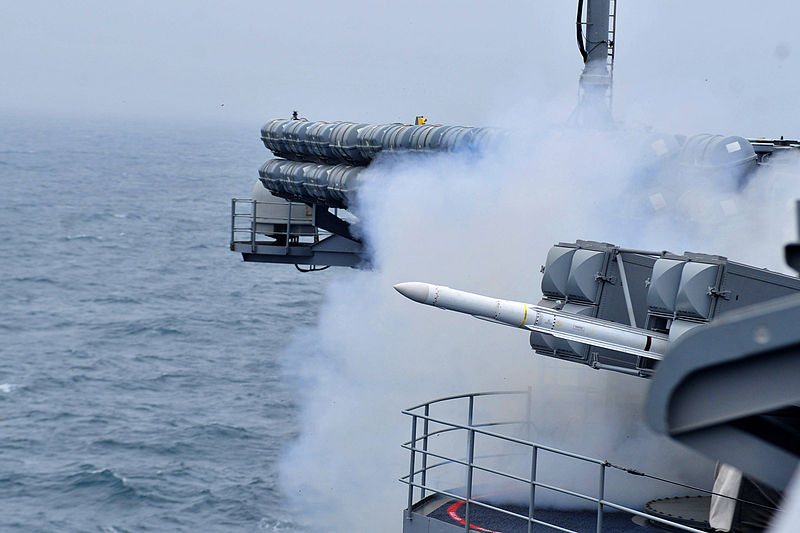
Enhanced Sea Sparrow launching from Carl Vinson
The middle layer is the Enhanced Sea Sparrow Missile (ESSM). This is a shorter-range missile (at least 30 nm), and a normal peacetime loadout is 24 on the CG and each DDG and 16 on the CVN. It is fantastically maneuverable, to the point that I was told that they basically come out of the VLS sideways.6 Because 4 can fit in each VLS cell, as opposed to a single Standard, a CVBG can in theory carry upward of a thousand. The US doesn’t have enough missiles in inventory to support this kind of loadout, but limited missile loadout is a global problem, and one we’ll come back to later.
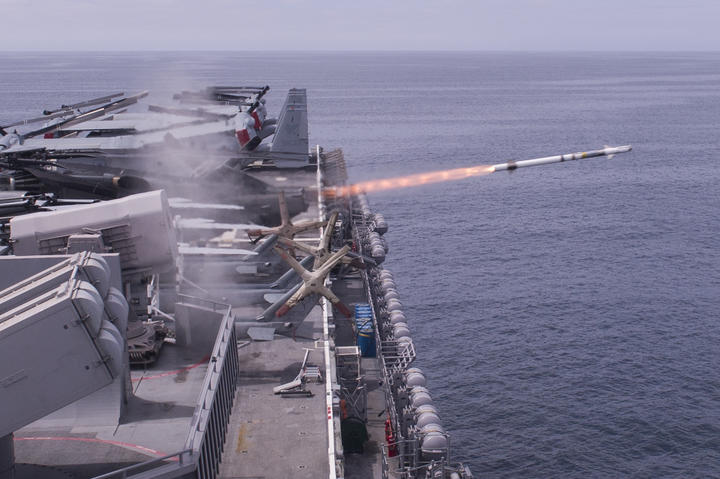
Rolling Airframe Missile launch from USS America
The inner layer is point-defense systems, designed to protect only the ship mounting them. There are two, the Rolling Airframe Missile (RAM) and the Phalanx Close-In Weapons System (CIWS). Almost all of the escorts mount one or more CIWS, which is a 20mm gatling gun hooked up to a radar system that automatically shoots down anything it thinks is a missile. Unfortunately, it’s not that effective against high-speed missiles because the debris from even a shot-down missile can still strike the ship. The RAM was designed to solve this, shooting down missiles at greater range. A carrier carries 2 21-round RAM launchers.
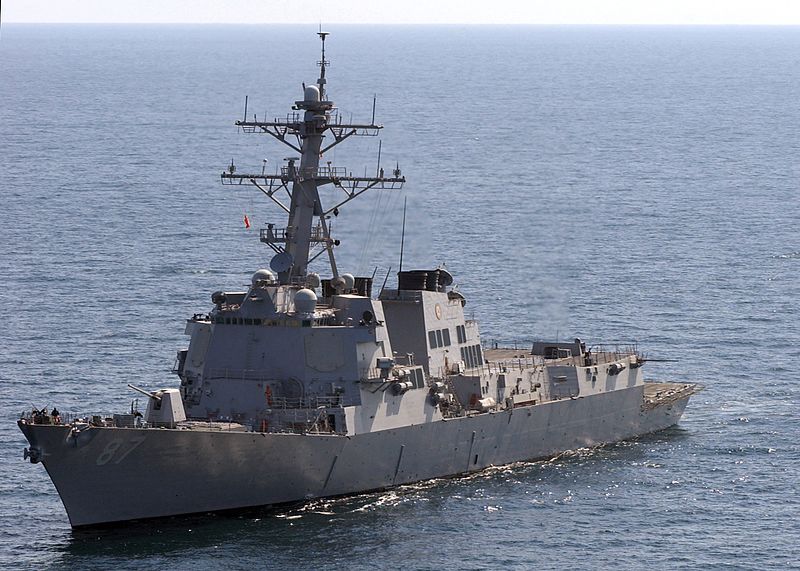
Destroyer Mason, recently attacked by missiles off Yemen
Now it’s time to look at how many missiles we’d need to overwhelm a carrier’s defenses. A typical group with the sort of peacetime loadouts we’d expect if we were going up against Enemyistan would have 96 Standards, 112 ESSMs, and 42 RAMs, a total of 250 missiles. Based on recent experience off of Yemen, I think it’s very conservative to assume that you’ll have a 50% kill probability against a typical missile with one of these weapons.7 Under this assumption, the CVBG can shoot down 125 incoming ASMs.8 With the loadouts you’d expect in a war with China, that number could top 200.
But there are other defenses besides missiles. There’s also electronic warfare to consider. This is a fantastically complicated topic, and we can’t know the answer without an actual war, but I think it’s reasonable to assume that EW will draw off about 50% of missiles that get close enough to be affected. That point is probably somewhere in the ESSM engagement zone, and before the RAMs come into play. So for our fight with Enemyistan, we have 48 missiles shot down by Standards, and 28 shot down by ESSMs before the EW takes effect. To saturate the rest of the defenses will require 49 missiles to not be drawn off (28 from ESSM, 21 from RAM) and another 49 to be drawn off, taking the number of missiles the CVBG can handle to 174. If the missiles in question are subsonic,9 then the Phalanx on a targeted ship will probably take out another 2-3. If the missiles are trickling in over a longer period, that might go up. Taking all of this into account, we have a round number for Enemyistan of 175 missiles to make one possible hit on a carrier. One hit is not going to kill the carrier outright, although she might have to go home to repair. I’ve done my best to systematically err in favor of the attacker, so a more midline estimate might be 200 missiles. With anything less, the CVBG will have to go home to reload, but it’s still alive, and the next carrier coming up behind it doesn’t have to face those missiles.
So the next question is how many missiles Enemyistan is likely to be able to put in the air towards the carrier group, and how this compares to our estimates of the carrier’s defenses.
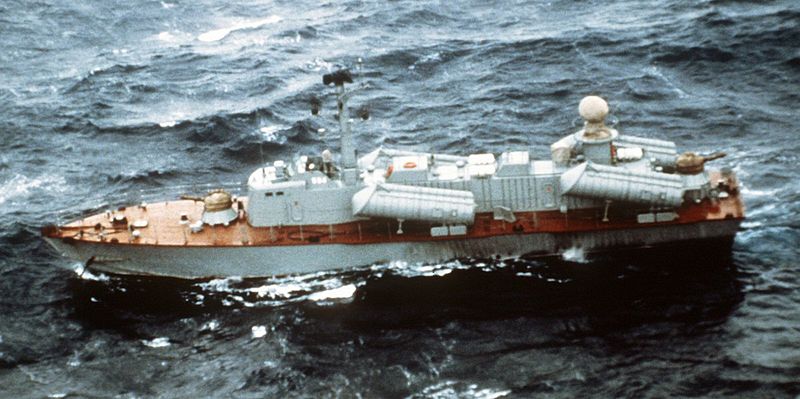
Osa II class missile boat
Unfortunately for Enemyistan, they are going to have a very difficult time of it. A typical surface warship carries 4-8 ASMs, and an airplane is going to carry 2-4, so a very large attack force will be needed. More than that, most minor powers usually tend not to buy that much ammunition. A typical second-rate navy only has the missiles in the tubes, and no spares ashore. For a real-world example, the Iranian navy had a total of about 200 missile tubes on its surface combatants as of early 2018, including the ones then under construction. Obviously, air-launched and shore-based missiles could be added to this in a coordinated strike, which might allow the destruction of the carrier.10 However, the number available is going to plunge when you take into account all of the various ways that missiles and launch platforms can be lost. Besides the obvious, such as US counterattacks, you have launch platforms out of service with mechanical problems, missiles not fired or sent to an empty part of sea due to problems with targeting data, missiles which fail due to lack of maintenance, and missiles which pick the wrong target, and get shot down by the CIWS on one of the DDGs. A lot of work by the great powers goes into making sure that these problems are minimized, but minor powers tend to optimize for the easy-to-understand and impressive metrics like quantity of missile tubes.
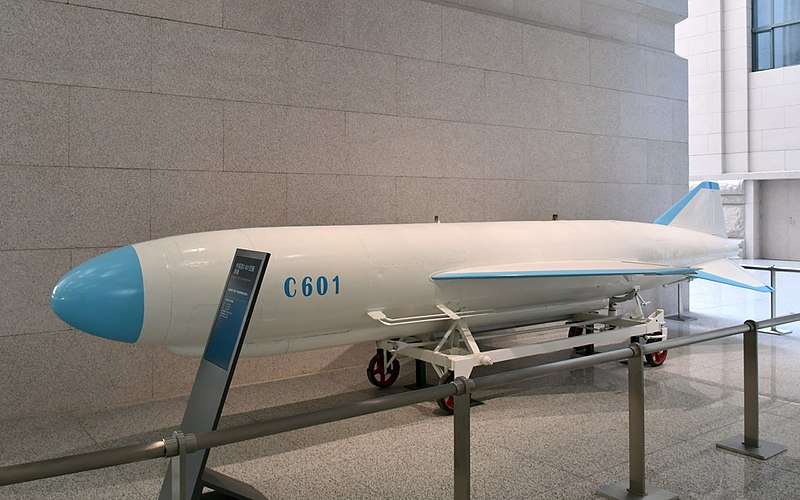
Chinese C-601 Silkworm anti-ship missile
Ultimately, the best case for Enemyistan is that they sink one US carrier, then get smashed by the next two CVBGs behind it, which they have no missiles left to engage. A more likely case is that they either sink a couple of merchant ships that were where they thought the US carrier was or launch an attack that gets shot down, then get destroyed by all three CVBGs.
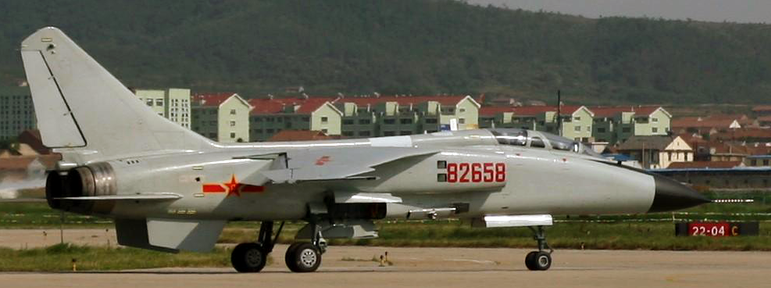
People's Liberation Army Navy Air Force JH-7A strike airplane
China is going to be a tougher nut to crack. Obviously, they have more missiles and platforms, enough so that launching a couple of 200+-missile salvoes is not out of the question. And they’re going to do a better job of solving the problem of making sure that the missiles are fired and fired at the right place. China has approximately 224 naval strike aircraft, each of which can probably carry 2 missiles. That’s almost certainly enough to overwhelm a single CVBG, even in wartime, but a lot of the attacking aircraft would likely be destroyed in the attack and they would probably be unable to take out a second CVBG the same way. And the US has 9. However, two CVBGs operating together could put up a serious defense to that level of firepower, and US counterattacks are likely to reduce the number of strike aircraft available. Much the same math applies to shore-based and shipboard ASM launchers, although I’m not going to go into detail on them. The ultimate balance between US naval forces and the Chinese is pretty close right now, and the only obvious potential ‘killer app’ on the horizon is lasers, although it's going to be a while before those make the carriers more survivable.
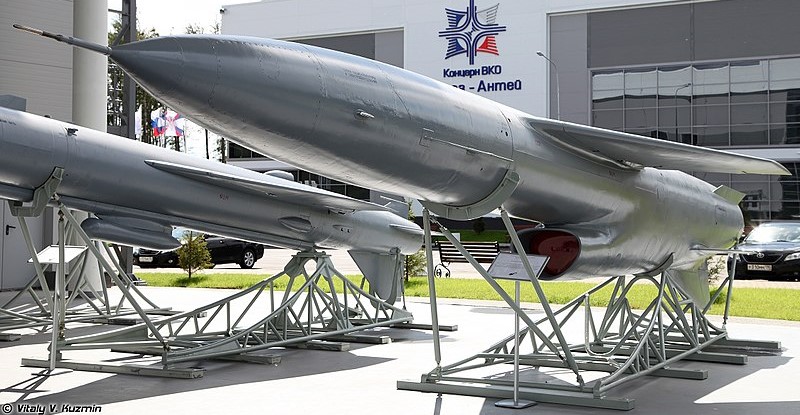
Russian P-500/SS-N-12 supersonic ASM
All of this has been assuming conventional anti-ship cruise missiles. The vast majority of these today are designs that date back to the 60s or 70s, and are subsonic weapons like Harpoon, intended to kill frigates of up to maybe 4,000 tons. There are a few super/hypersonic ASMs with larger warheads around, but they’re larger and much more expensive. To a first approximation, the gains from higher speed are pretty much balanced out by the ‘virtual attrition’ of fewer missiles and the fact that they can't fly as low as slower missiles, increasing the response time of the system. Anti-ship Ballistic Missiles (ASBMs) are outside the scope of this particular analysis, but I’ll deal with them next time.
1 CVBG is the designation for a carrier battle group. CV is the navy’s designation for an aircraft carrier. Nobody is totally sure where the V comes from, although the leading candidate is the French volplane, to fly. ⇑
2 Actually, in a really high-threat scenario, multiple CVBGs are likely to operate together, as was done during the late Cold War. ⇑
3 It’s the Ship of Theseus by now, but the design lineage goes back that far. ⇑
4 I’m not sure of the exact mix of MRs and ERs. ⇑
5 I'm getting my missile loads from the game/simulator Command Modern Operations, which has been the beneficiary of a tremendous amount of research. I used it here to look more at the math of missile defense. That said, the 2023-2024 clashes off Yemen suggest that CMO's loads are on the low end. ⇑
6 Carriers use box launchers instead of VLS. ⇑
7 A more realistic number is 70%, coming from CMO, but I’m trying to be conservative. ⇑
8 Aegis is smart enough to retarget missiles in flight, so it gets more than one chance with each level of missile. ⇑
9 The vast majority of ASMs worldwide are, and I’d expect higher-speed missiles to be preferentially targeted. ⇑

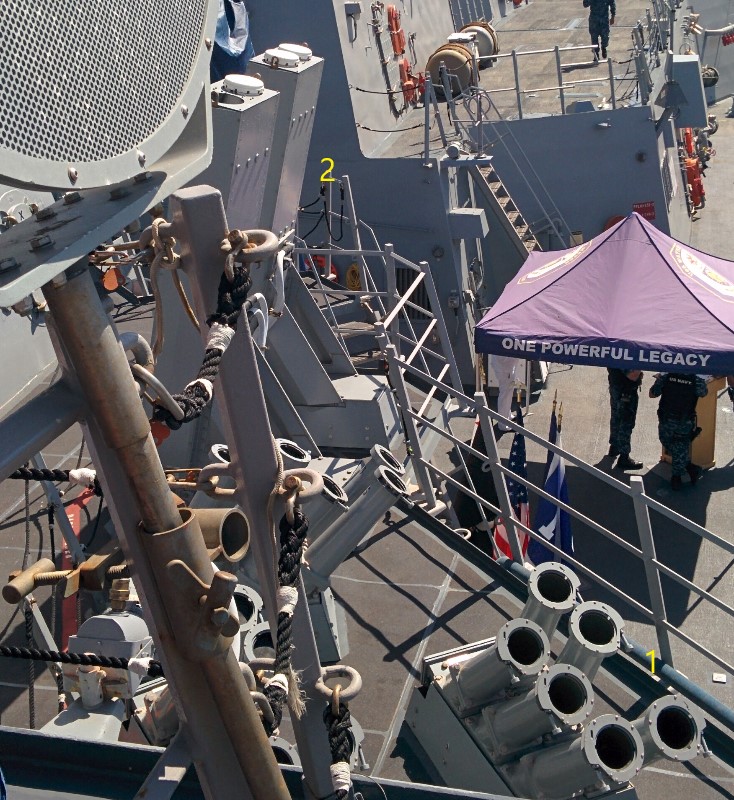
Comments
V stands for aViation. ("A" was already taken for Armored - CA is "cruiser, armored", CL is "cruiser, light", and CV is "cruiser, aviation" -- the CV designation stuck even after carrier tonnage went zooming upwards with the Midways and the post-WWII carrier classes.)
Not quite. There’s no firm documentation, but apparently (and I didn’t remember this when writing) the consensus is that it comes from the French volplane, to fly. (Ref is US Naval Aviation 1910-1995.)
Edit: CA wasn't adopted until 1920, the same year CV was chosen for the carriers. Before that, it was ACR. Z was adopted for the lighter-than-air forces, apparently after Zeppelin.
Admit it, you put up the picture of the JH-7A just so you could have a caption about the People's Liberation Army Navy Air Force (the Chinese really need to work on their naming convention).
I wish I could claim credit for that, but it wasn't really intentional. I wanted something about Chinese coastal defense forces, and their strike aircraft were the easiest to find pictures of. But it is kind of funny, and I agree that the naming is amusing.
I mean, the Chinese naming is saner in some ways than ours. Marine Corps Aviation may roll off the tongue well, but they really are the navy's army's air force.
(And they're the reason the F-35 is...what it is. Or at least, the fact that the air force is buying the same fucking plane as the navy's army's air force.)
Well, yes. But so what? They do what they need to do.
This is an issue I should deal with at some point, but my plate is pretty full. There are lots of issues with the F-35, but the core problems have a lot more to do with them pushing the envelope on the combat systems than with the rather odd aerodynamic design choices. The F-35 has four times the lines of code of the F-22, and developing military software takes a lot more work than the equivalent civilian software because you can't afford bugs. The Space Shuttle (which was run on a fairly similar model) did about one line per developer per day.
Have you calculated those probabilities correctly, though? If the CVBG has a 50% chance of stopping one missile, then there's only a 25% chance of stopping two, a 12.5% chance of stopping 3, etc. It seems like you're assuming the first 50% of missiles would all be stopped, and then the next 50% would get through.
50% is the probability of a given SAM getting a hit in an engagement, not of a missile getting through the entire set of defenses. Aegis can retarget missiles in flight, so you get several chances with each ring of defenses. Rate of fire isn't really the limiting case with modern Air Defenses systems, so I believe my approximation is good. I have a post covering this in more detail coming up in a couple weeks.
I was going to save this for the submarines post, but I think it really belongs here.
Since the prospects for approaching a carrier by air are so dismal, why can't your ship killers make their final approach underwater--like an ASROC, but for use against surface ships? It seems like no one has ever considered anything like this and I'm sure it wouldn't work, but I'd like to know exactly why.
Some quick numbers lookups reveal a few difficulties. Surveying torpedo specs, it looks like range is typically 20 nm, about a tenth what we need to stay outside missile defense range. ASROC torpedoes have shorter ranges, but standard torpedoes are probably closer to what we need in this role.
I lack a lot of implicit knowledge here, but taking the crudest possible approach and basically assuming linear scaling on nigh-arbitrarily chosen existing tech...
Wiki says the Iranian navy uses the C-802 as their anti-ship missile. It carries a ~200kg warhead. The Mark 48 torpedo is 1600 kg. So eight C-802s could deliver one Mark 48 to a given point. If you can build a 10x-ranged Mark 48 by making it ten times as heavy, this gives eighty missiles to deliver one torpedo. Sounds like a lot, but according to this post, launching those eighty missiles the normal way would accomplish a whole lot of nothing. And I'd guess the scaling is substantially more efficient than this, if it's not completely impossible. Though on the other hand those eighty missiles are probably a lot more versatile, being able to do things like sink eighty Enemysenemyistani ships...
And I haven't forgotten Part I! Torpedoes are slower than missiles, and by the time one has gone 200 nm, the carrier won't be where it was when the torpedo went under. So my next question: can you ping updated target info to a torpedo in transit? Or more to the point, do this in a way that can't be spoofed or jammed?
I also wouldn't bet on Enemyistan being able to build a torpedo that can discriminate USN ship classes (is the reverse even possible?), so probably the best case here is taking out a random member of the group, but that's nothing to sneeze at if the rest works out.
That's an interesting idea, but you're right, it wouldn't work. (Also, the idea of a gliding torpedo isn't new.)
There's two related problems, speed and sensors. A torpedo's theoretical range is usually very optimistic because torpedoes aren't that much faster than their targets. If I have a 20 nm 60 kt torpedo shooting at a 30 kt target, I only have an effective range of 10 nm. In practice, it's less than that. And the max range and max speed you see quoted for torpedoes are usually mutually exclusive.
On the sensor front, you have a couple of issues. Sonar range is shorter than radar for a given size/weight, so the big problem is usually finding anything to attack, not discriminating between targets. It's normal for submarine torpedoes to be wire-guided, which allows the submarine's sonar to pass updates to the torpedo. When it acquires the target, the wires are cut. There's not another good way to transmit data to the torpedo. Maybe you leave the missile body floating, and use a satellite link to pass data to it, then to a wire. But if the other guy knows you have this, his ASW helicopters are going to be looking for it.
That's actually relatively easy. Ships have fairly distinctive sonar signatures, and I don't think it would be particularly difficult to tell the difference between a CVN and a DDG.
How about dropping sonobuoys along the route and using their pings to transmit a code? I'd be very surprised if this weren't at least possible absent countermeasures.
How do you get the sonobuoys in position?
It's theoretically possible to make this sort of thing work, but the practical problems are just too great for it to have ever been done.
It depends how big the sonobuoys are (with whatever reduction you get from removing the receiving equipment). If they're small enough you could launch a whole lot of them on small rockets, such that each one requiring a missile to take out would be a favorable exchange.
And thinking about this gave me another harebrained weapon idea: the 'flying fish' missile/torpedo. Approach as a missile, then when the intercepting missiles get launched, you dive into the water, wait out their flight time (and maybe move a little to clear datum a bit), then launch into the air again. Final approach is probably underwater since at close range you can't dive in time. My two guesses for why this wouldn't work: 1) Initial acceleration consumes a lot of fuel, and having to do it multiple times would be prohibitive. 2) ASW aircraft could find and destroy it while submerged.
For 1) I see that the Harpoon's booster adds about 20% to weight. If we assume every additional launch adds another 20% to weight (multiplicatively)... you probably couldn't have enough to get all the way through, but it seems like having several of these would be easily paid for by the extra missiles required to stop them.
Small rocket means small range. You need to lay a trail of sonobuoys (which these aren't really) to the target from outside range of the defenses. That’s going to get expensive.
Clever, but you’re firmly into German Wonderwaffe territory. You’ve identified a couple of the main problems. Several others:
Flight time goes way up. The defender takes a shot, putting it into the sea. He then runs away. Repeat a couple times. By the time you get to where the carrier was, it’s long gone, and you just make Maersk’s insurers sad.
The mechanics are really dubious. A lot of missile systems work because they’re one-shot. Restart capability drives up size. Likewise, getting a missile underwater quickly is really tricky. You have to be fairly slow unless you drive your weight way up. Which means more cost. And the reconfiguration is just more complexity, which drives up cost and reduces reliability.
How do you know when you’re being shot at? Radar and visual sensors are out as options, and IR is dubious (and easy to fool with a bit of work). So that leaves passive radar, which is also easy to fool. They simulate a missile launch, the incoming dives, repeat until it runs out of boosters.
Cost. This will be expensive. Development included, I could buy a whole bunch of regular SSMs. Probably enough to give me a better chance.
But seriously, A for effort.
Thanks. I think I'm done for now : )
I think this is pretty convincing for what would happen in a very near term shooting war, but two potentially relevant items for the mid term future are the potential for electronic warfare disruption of Ageis and similar systems and the cost asymmetry.
Wikipedia numbers and some basic arithmetic suggests 200 Tomahawks cost ~1/50th as much as a new Ford class carrier and I'm not clear if that unit cost is including the air wing and such or just the vessel narrowly defined. I suspect the numbers are more favorable to the YJ-83, C803 ect. but haven't been able to find good sources. Now that is obviously not including the launch platforms or similar but it does make me wonder about the possibility for China or similar to build an actually fleet neutralizing amount much more cheaply than getting their own carrier fleet. Particularly if they only need regional coverage.
Also, for the Enemyistan situation, there are a lot of circumstances where (leaders could plausibly believe) that the US would be willing to see a place bombed but not willing to seriously risk a carrier. So just being able to meaningfully shoot back at a carrier that tries anything greatly reduces the value of carriers showing the flag, even if Enemyistan is under no illusions about actually being able to physically deny the USN access to the area.
Also "typical surface warship carries 4-8 ASMs," seems low. I guess you probably have better idea of what counts as typical on a global level but the Hobarts and even the outdated Adelaides have an order of magnitude higher loadout than that.
Re EW and Aegis, that's obviously a concern, but AIUI phased arrays are pretty resistant to that sort of thing. EW is likely to limit effectiveness, but probably not destroy it entirely.
As for cost, well, a carrier isn't what you buy if you're just expecting a missile duel. We buy it because it's useful for other things, too.
China hasn't seemed to go this way, though.
Re ASMs, note that this is anti-ship missiles, not SAMs or other kinds of missiles. A Hobart has 8 Harpoons per Wiki, although they may have been swapped out for NSM right now. I suppose Adelaide might have been able to get significantly more if you filled the entire Mk 13 magazine with Harpoons, but that wasn't standard procedure, any more than VL-LRASM is likely to make up a supermajority of the VLS load on the Hobarts whenever they get that into service.
I misread the specs and thought the Hobart had the Tomahawk version of the Mark 41 Vertical Launch System not the RIM only only loadout.
"We buy it because it’s useful for other things, too." I'd don't want to go to deep into this because I've already spent more time than I probably should have playing devils advocate in an debate that isn't that relevant to me. But my point wasn't, there is a cheaper substitute rather it was if the countermeasure is cheap enough then they aren't actually useful for other things. E.g. two of the main things they are useful for are flag flying and actual airstrikes but if a country that couldn't afford a single carrier sans escort with there entire defense budget can buy enough missiles to down one if a shooting war starts then those go from things the US can do ~at will only subject political constraints to something that only only works in situations were it is worth trading a carrier for it. To loosely gesture at a historical analogue that was the first to come to mind and not necessarily the best, barbed wire is not remotely a substitute for (horse) cavalry but it did massively change the viability of cavalry.